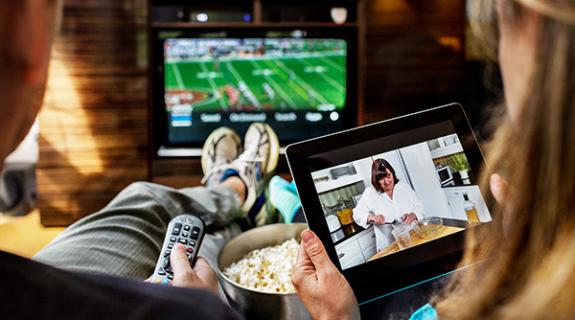“Make your promos your brand. And live up to the promises you made in your promos.”
When the average audience has three screens in their home, when there are so many different ways to consume content, when OTT is eclipsing linear viewing as we speak, reminding people that your programming exists is one of the key ways to make sure it continues to get eyeballs, and local media continues to survive.
So says Andrew Finlayson, EVP, digital and social strategies, SmithGeiger, who revealed down-to-the-minute data compiled specifically for the “OTT and Me” session at Station Summit 2017.
“We should all be thinking about streaming,” Finlayson said. “The world is truly going on demand.”
With 84 percent of the U.S. population owning a smartphone and 69 percent subscribed to a streaming service, live linear TV is down to less than 25 percent of total screen time, he said. Layered media, with people often on two or more screens at the same time, is the new norm. And marketers need to embrace those changing consumer habits.
Fortunately, the world is going video.
“And what do you guys do for a living?” Finlayson rhetorically asked a room full of local broadcast professionals.
But it’s not enough to have an established video brand. The marketing attached to it needs to make it stand out, and ensure that anyone interested in your video can find it on a regular basis.
“Your viewers are like people walking through a casino,” he said, making an analogy appropriate for the Vegas-based conference. “If you’re not their friend, if they don’t know you, they’re going to walk right by you.”
A good strategy comes down to what Finlayson calls conversational choreography: knowing your audience and talking to them, from using voice activation technology like Amazon Echo, to connecting with potential viewers on Facebook.
The average user spends 50 minutes a day on that social media platform, and with so many online video clips the company is indeed entering the television industry. Broadcasters need an hour-by-hour strategy of what to post on Facebook, and much of that content should remind viewers what to watch on your station.
For instance, 81 percent of people with DVRs fast forward through the commercials, but 55 percent will stop fast forwarding if they see a news update. And 51 percent pay attention to local news promos during commercial breaks.
“Promos work,” he said.
When audiences are busy binging a show on Netflix, they’re not going to turn it off to watch the local news at 10 p.m.—unless, that is, they saw an enticing reminder in their Facebook feed encouraging them to tune in.
“A significant portion of the audience is simply forgetting we exist,” he said. “Promos give people powerful reasons to reach for the remote and turn on your local newscast.”
Smartphones, he said, are the screen on where they are most likely to watch a local news promo. If broadcast marketers want to keep their jobs in five years, they need a five-year plan that focuses on a mobile-based social strategy that engages viewers, constantly reminding them of all the amazing content your station offers, and giving them compelling reasons to watch.
SmithGeiger’s research showed 84 percent of viewers on Facebook, 40 percent on Instagram and 37 percent on Twitter.
“If you reach one person,” Finlayson said, “You might be able to reach their friends.”
Tags:












































__twocolumncontent.jpg)











